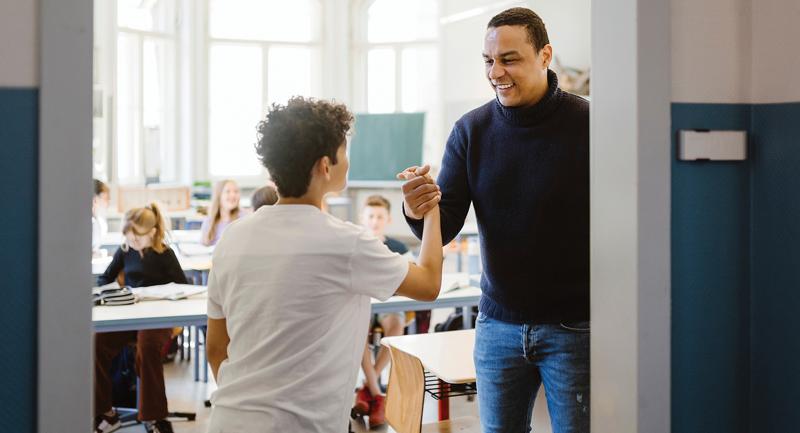Demand for social and emotional learning (SEL) is at an all-time high. More than 90 percent of teachers and principals want schools to make it more of a priority. They understand that a foundation of belonging and connectedness is important for creating safer, more equitable environments where all students participate and achieve. Employers from Allstate to Google understand the benefits of SEL, as well. For corporations, the ability to communicate and collaborate is just as important as knowledge of math and science. Most importantly, in a recent survey of 1,300 current and recent students, the majority wanted their high schools to do a better job of helping them learn skills such as building relationships and resolving conflicts.
The scientific evidence is also clear: evidence-based, SEL programming leads to improvements in mental health, social skills, and academic achievement (up to 11 percentile-point gains, according to a 2011 meta-analysis of over 200 research studies). A 2017 meta-analysis of research from around the world found that these benefits can last up to 18 years. From the Collaborative for Academic, Social, and Emotional Learning's (CASEL) perspective, SEL implementation should be systemic, including the following activities:
- Building foundational support and a robust plan for SEL
- Strengthening adult SEL competencies and capacity
- Promoting SEL for all students in classrooms, throughout the school, and in partnership with families and community partners
- Practicing continuous improvement
SEL's focus on the whole child invites us to think of school safety in more comprehensive ways than we might otherwise. The climate of a school is considered safe and supportive when members of the school community feel socially, emotionally, and physically safe, when they feel respected and can contribute to how the school operates, and when school staff model and nurture the attitude that learning is beneficial and satisfying. Many schools recognize that cultivating the social and emotional competencies of adults and students fosters this type of school climate and is integral to their work to create safer schools.
Practical Tools and Guidance for Schools
In January 2019, CASEL released an important new resource that provides field-tested, practical guidance for cultivating safe, equitable learning environments that promote social, emotional, and academic learning. The CASEL Guide to Schoolwide SEL is a free, online resource that helps school teams coordinate and build on their evidence-based practices and programs to implement SEL systemically. Using the online interactive planner, educators can reflect on their current implementation, set priorities and goals, and create action plans with integrated guidance to help them advance their work. Others may want to dive right in to information on a specific topic such as building a safe and supportive classroom and school environment.
Systemic SEL implementation takes a coordinated approach that engages the entire school, all classrooms, families, and community partners. For example, a coordinated approach that leads to safer schools would include establishing schoolwide discipline policies that promote SEL and equitable outcomes, leveraging strategic and aligned community partnerships that ensure students receive consistent SEL supports, and creating meaningful partnership opportunities and two-way communication with families.
As part of this systemic approach, we share ideas for creating a sense of belonging and emotional safety within the classroom. Educators can do this by building a sense of community, responding to students' perspectives and needs, affirming all students' full identities, and establishing structures that create predictability and consistency.
Community Building
By building the relationships that allow learners to feel a sense of community—that they are "in this together"—teachers create a safer, more equitable environment where all students participate and achieve. Teachers can develop structures that help students get to know each other and take active roles in building classroom community.
One powerful strategy to set up these types of structures is to create classroom shared agreements. These agreements, which are different than rules developed and enforced by adults, reflect students' shared understanding of how they wish to be treated and will treat one another. Prominently displayed in the classroom, they reinforce SEL and help create a shared sense of purpose and ideals. This tool can help teachers get started: Sample Lesson Plan: Generating Classroom Shared Agreements.
Responding to Students' Perspectives and Needs
To feel emotionally safe, students need teachers who respond to their needs. When teachers elicit students' perspectives, they better appreciate how students experience classroom life, including where they find joy and struggle. To better understand students' perspectives, teachers can:
- Conduct regular student surveys to gather feedback on classroom activities, instruction and climate;
- Schedule one-on-one check-ins to listen attentively to students as individuals;
- Ask students to write a <LINK URL="https://schoolguide.casel.org/uploads/2019/01/Tool-Learner-Autobiography-Lesson-Plan.docx" LINKTARGET="_blank">learner autobiography</LINK> that provides information on the best ways to support and challenge them; and
- Engage in professional learning that supports relationship-building. The <LINK URL="http://www.corclassrooms.org/" LINKTARGET="_blank">Creating Opportunities through Relationships</LINK> modules provide free online learning for educators.
Affirming Student Identities
Teachers who affirm students' identities communicate that show they genuinely care for and respect each student, and that they believe each student's knowledge, experiences, and culture offer assets to the classroom community. To affirm student identities, teachers can
- Ensure that students see themselves curriculum. When choosing materials, consider diversity between and within cultural or socioeconomic groups.
- Ask students to share from their lives and backgrounds.
- Elevate students' voices and perspectives by engaging the entire class in <LINK URL="https://schoolguide.casel.org/uploads/2019/01/Shared-Classroom-Goals-.docx" LINKTARGET="_blank">problem-solving conversations</LINK> to address challenges. Be receptive to student input while consistently helping students look for inclusive, mutually beneficial solutions.
- <LINK URL="http://www.tolerance.org/sites/default/files/documents/tt_questions-3.pdf" LINKTARGET="_blank">Reflect</LINK> on how students participate in and perceive the classroom.
Establishing Consistent Routines and Procedures
Effective routines, procedures, and structures help reduce stress and facilitate learning for all students (Darling-Hammond et al, 2017), including those who have experienced trauma, are on the autism spectrum, or struggle with behavior.
Carefully planned routines and procedures provide opportunities for student leadership and SEL. Ideally, teachers will develop these routines and procedures before the school year begins, but if not, your team may want to support teachers in establishing or re-establishing their routines to support SEL. Make both the procedures and rationale explicit and, as the year goes on, help students actively participate in designing and maintaining an inclusive and safe classroom. Your SEL team can use this tool to support teachers in planning classrooms routines and procedures: Planning Procedures for Supportive Classroom Environments.
Perspectives from the Field
Anamaria Orbe, the principal of Chicago's Hammond Elementary School, has found the CASEL Guide to Schoolwide SEL helpful in focusing and improving her school's SEL activities. According to Orbe, the guide's central organizing focus areas were critically important. "The Guide helped us evaluate exactly where we were, and we realized we needed to do more as a team and secure buy-in from the entire staff. We went back through the key activities of building ownership and developing a shared vision and plan." Orbe and her team also used the guide to develop their strategy around adult SEL. "Now, as we focus on adult SEL, we realize how important it is to model the behavior we want in our students. By the end of this school year, we are confident all staff will be on board. The Guide has given us tools and strategies to do that."
Social and emotional learning is not an easy fix for the challenges our schools face to provide all students with a safe, supportive environment. But when implemented with intention and fidelity, SEL can help to positively transform the way we reach and teach the whole child.







